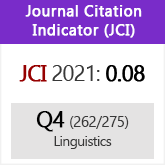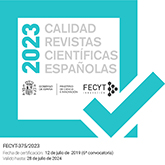Phrasing and nuclear configurations in authentic English-accented Spanish
DOI:
https://doi.org/10.3989/loquens.2018.050Keywords:
imitated and authentic English-accented Spanish, phrasing, nuclear configuration, boundary tonesAbstract
This paper examines the differences in the division of intonation phrases and in the tonal structure of the nuclear configuration (i.e., the last pitch accent and the following boundary tone) in imitated and in authentic English-accented Spanish. The same Spanish text was read by four native speakers of American English, who produced the text with a real English foreign accent in Spanish, and six native speakers of Spanish, who read the text twice: in L1 Spanish and in fake English-accented Spanish. An auditory analysis of the data was carried out along with an inspection of the f0 traces aligned with the spectrographic representation and the segmental string. The results showed that the Spanish speakers produce more intonation breaks when they imitate an English accent in Spanish than when they speak L1 Spanish. Furthermore, they adopt the typical tonal structure of Spanish final accents in their fake English-accented productions. The number of prosodic breaks in real and in imitated English-accented Spanish is similar. The nuclear configurations, on the other hand, present more variability and differ in the frequency of occurrence of some patterns. The high occurrence of the fall-rise pattern (L+H* LH%) and the presence of the high-fall contour (L+H* L%) in the English productions may help discriminate an authentic English-accented Spanish from a fake one.
Downloads
References
Alcina, J., & Blecua J. M. (1975). Gramática española. Barcelona: Ariel.
Beckman, M. E., Díaz-Campos, M., McGory, J. T., & Morgan, T. A. (2002). Intonation across Spanish, in the Tones and Break Indices framework. Probus, 14(1), 9–36. https://doi.org/10.1515/prbs.2002.008
Bruyninckx, M., Harmegnies, B., Llisterri, J., & Poch-Olivé, D. (1994). Language-induced voice quality variability in bilinguals. Journal of Phonetics, 22(1), 19–31.
Cicres, J., & Fernández Trinidad, M. (2017). Análisis de los sonidos fricativos en un corpus de acento no nativo disimulado. In V. Marrero Aguiar & E. Estebas Vilaplana (Eds.), Tendencias actuales en fonética experimental. CIFE 2017 (pp. 308–312). UNED: Madrid.
Couper-Kuhlen, E. (1986). An Introduction to English prosody. London: Edward Arnold.
Cruttenden, A. (1986). Intonation. Cambridge: Cambridge University Press.
de-la-Mota, C., & Rodero, E. (2011). La entonación en la información radiofónica. In A. Hidalgo Navarro, Y. Congosto Martín & M. Quilis Merín (Eds.), El estudio de la prosodia en España en el siglo xxi: Perspectivas y ámbitos (pp. 159–176). Facultat de Filologia, Traducció i Comunicació, Universitat de València.
Estebas-Vilaplana, E. (2017a). Análisis de los rasgos prosódicos en el acento imitado: El caso de las enumeraciones. In V. Marrero Aguiar & E. Estebas Vilaplana (Eds.), Tendencias actuales en fonética experimental. CIFE 2017 (pp. 116–120). UNED: Madrid.
Estebas-Vilaplana, E. (2017b). How imitation can help the acquisition of L2 pronunciation. In Proceedings of the Phonetics Teaching and Learning Conference 2018. London: University College London. 9–11 August. Retrieved from https://www.ucl.ac.uk/drupal/site_pals/sites/pals/files/ migrated-files/PTLC-Proceedings-2017.pdf
Estebas-Vilaplana, E., Gutiérrez, Y. M., Vizcaíno, F., & Cabrera, M. (2015). Boundary tones in Spanish declaratives: Modelling sustained pitch. In The Scottish Consortium for ICPhS 2015 (Ed.), Proceedings of the 18th International Congress of Phonetic Sciences. Glasgow, UK: The University of Glasgow, paper number 196, 1–4. Retrieved from https:// www.internationalphoneticassociation.org/icphs-proceedings/ICPhS2015/Papers/ICPHS0196.pdf
Estebas Vilaplana, E., & Prieto Vives, P. (2008). La notación prosódica del español: Una revisión del Sp_ToBI. Estudios de Fonética Experimental, 17, 263–283.
Face, T. L. (2007). The role of intonational cues in the perception of declaratives and absolute interrogatives in Castilian Spanish. Estudios de Fonética Experimental, 16, 185–225.
Garrido, J. M. (1996). Modelling Spanish intonation for text-to-speech applications (PhD Thesis). Bellaterra: Universitat Autònoma de Barcelona.
Garrido, J. M. (1999). El reajuste de F0 como marca fonética de límite entre unidades entonativas: Un estudio experimental. In Actas del Primer Congreso de Fonética Experimental (pp. 233–239). Tarragona: Universitat Rovira i Virgili / Barcelona: Universitat de Barcelona.
Garrido, J. M. (2001). La estructura de las curvas melódicas del español: Propuesta de modelización. Lingüística Española Actual, 23(2), 173–209.
Gibson, M., Blecua, B., & Cicres, J. (2017). Are American English speakers better at distinguishing fake English accents in Spanish than native Spanish speakers? In M. Belz, S. Fuchs, S. Jannedy, C. Mooshammer, O. Rasskazova, & M. Zygis (Eds.), Tagungsband der 13. Tagung Phonetik und Phonologie im deutschsprachigen Raum (P&P 13). 28.–29. September 2017: Berlin.
Hualde, J. I., & Prieto, P. (2015). Intonational variation in Spanish: European and American varieties. In S. Frota & P. Prieto (Eds.), Intonation in Romance (pp. 350–391). Oxford: Oxford University Press. https://doi.org/10.1093/acprof:oso/9780199685332.003.0010
Künzel, H. J. (2000). Effects of voice disguise on speaking fundamental frequency. Forensic Linguistics, 7(2), 149–179.
Markham, D. (1999). Listeners and disguised voices: The imitation and perception of dialectal accent. Forensic Linguistics, 6(2), 289–299. https://doi.org/10.1558/sll.1999.6.2.289
Masthoff, H. (1996). A report on a voice disguise experiment. Forensic Linguistics, 3(1), 160–167.
Navarro Tomás, T. (1974 [1944]). Manual de entonación española. New York: Spanish Institute in the United States.
Neuhauser, S. (2008). Voice disguise using a foreign accent: Phonetic and linguistic variation. The International Journal of Speech, Language and the Law, 15(2), 131–159.
Neuhauser, S., & Simpson, A. P. (2007). Imitated or authentic? Listeners' judgments of foreign accents. In J. Trouvain & W. J. Barry (Eds.), Proceedings of the 16th International Congress of Phonetic Sciences (pp. 1805–1808). Saarbrücken.
O'Connor, J. D., & Arnold, G. F. (1973). Intonation of colloquial English. London: Longman.
Prieto, P., & Roseano, P. (Eds.) (2010). Transcription of intonation of the Spanish language. Munich: LINCOM Europa.
Quilis, A. (1993). Tratado de fonología y fonética españolas. Madrid: Gredos.
Rodman, R. D. (1998). Speaker recognition of disguised voices: A program for research. In Proceedings of the Consortium on Speech Technology in Conjunction with the Conference on Speaker by Man and Machine: Direction for Forensic Applications (pp. 9–22). Ankara, Turkey: COST 250.
Schoonmaker-Gates, E. (2012). Perception of foreign accent in Spanish by native and nonnative listeners: Investigating the role of VOT and speech rate (PhD dissertation). Bloomington, IN: Indiana University.
Storey, K. C. (1996). Constants in auditory and acoustic voice analysis in forensic speaker identification in cases of disguised voice. Recent Developments in Forensic Linguistics, 203–216.
Tate, D. A. (1979). Preliminary data on dialect in speech disguise. In H. Hollien & P. Hollien (Eds.), Current Issues in the phonetic sciences (847–850). Amsterdam: John Benjamins.
Tench, P. (1996). The intonation systems of English. London: Cassell.
Wells, J. C. (2006). English Intonation: An introduction. Cambridge: Cambridge University Press.
Published
How to Cite
Issue
Section
License
Copyright (c) 2018 Consejo Superior de Investigaciones Científicas (CSIC)

This work is licensed under a Creative Commons Attribution 4.0 International License.
© CSIC. Manuscripts published in both the printed and online versions of this Journal are the property of Consejo Superior de Investigaciones Científicas, and quoting this source is a requirement for any partial or full reproduction.All contents of this electronic edition, except where otherwise noted, are distributed under a “Creative Commons Attribution 4.0 International” (CC BY 4.0) License. You may read here the basic information and the legal text of the license. The indication of the CC BY 4.0 License must be expressly stated in this way when necessary.
Self-archiving in repositories, personal webpages or similar, of any version other than the published by the Editor, is not allowed.















